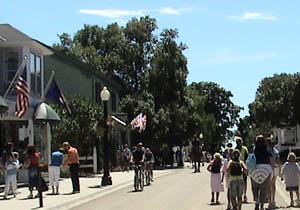
Transportation in Bicycle City
|
Perhaps Bicycle City’s most unique feature is that cars and other motorized vehicles will not be permitted inside our community. Our residents can own vehicles, of course, but they will have to leave them on the perimeter of the community, in a lot or garage that we will construct.
 |
| Mackinac Island, Michigan |
Instead of relying on cars, highways, parking lots, meters, gas and traffic congestion, our residents and visitors will rely on themselves. Human-powered transportation is the cleanest there is, and in addition to keeping the air free of harmful emissions, human-powered transportation will add physical fitness to our daily lives. While it may be hard to imagine walking to the grocery store in the community in which you currently live, Bicycle City will be designed so that everything will be within comfortable walking distance.
 Imagine the peacefulness of riding a bike on a tree-lined path to the organic market or the convenience of walking your children to school. Think of how fun it might be to strap on a pair of roller blades and meet friends for a movie! All this, free from concern over fast-moving vehicles and without contributing to the precarious climate situation.
Imagine the peacefulness of riding a bike on a tree-lined path to the organic market or the convenience of walking your children to school. Think of how fun it might be to strap on a pair of roller blades and meet friends for a movie! All this, free from concern over fast-moving vehicles and without contributing to the precarious climate situation.

Ideally, Bicycle City communities can be linked via rail and trail lines.